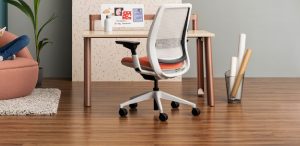Picture this: You’ve just finished pouring your heart and soul into restoring your hardwood floors, their rich glow radiating warmth throughout your home. But as you relish the beauty of your handiwork, a knot of dread forms in your stomach. You envision your beloved chairs, the silent culprits of countless scratches etched into the pristine surface. The nightmare of scratching your floors is enough to make anyone cringe, right? Don’t despair! This guide is jam-packed with the best ways to keep your hardwood floors pristine and your chairs scratch-free, ensuring a beautiful and long-lasting home.

Image: officefixes.com
Protecting hardwood floors from chair scratches is a common concern, especially for those with modern furnishings and a commitment to maintaining their home’s aesthetic. The good news is that numerous strategies, both preventative and restorative, are available. With just a little effort and the right tools, you can safeguard your floors and enjoy the elegance of your home without worrying about every chair movement.
Understanding the Problem: Why Do Chairs Scratch Hardwood Floors?
Hardwood floors, while beautiful and durable, are also susceptible to scratches. Chairs, especially those with metal legs or sharp edges, can readily mar the surface. The combination of weight and friction, especially when chairs are moved frequently, can lead to gradual wear and tear. The type of hardwood, the finish, and the frequency of movement all contribute to the severity and visibility of scratches.
The Ultimate Protection: Choose the Right Chair Leg Protectors
When it comes to safeguarding your floors, chair leg protectors are your best friends. They provide a barrier between the chair legs and the floor, minimizing friction and preventing damage. Here’s a breakdown of the most popular types of protectors:
- Felt Pads: These are the most common and affordable option. Felt pads adhere easily to chair legs and offer decent protection against scratches. They are available in a range of colors and sizes, making them suitable for various furniture styles.
- Rubber Pads: Rubber pads provide a bit more grip and cushioning compared to felt, preventing slippage and offering superior protection against scratches. They are particularly effective on chairs with heavy bases.
- Plastic Caps: Plastic caps are a robust choice, offering a more long-lasting solution compared to felt or rubber. They come in various shapes and sizes, making them adaptable to different chair leg designs.
- Self-Adhesive Pads: These pads are readily available and provide a quick and easy way to protect your floors. They are perfect for temporary solutions or for frequent furniture rearrangements.
Additional Tips for Protecting Your Hardwood Floors
Beyond chair leg protectors, there are several practical strategies for safeguarding your hardwood floors from scratches:
- Regular Cleaning: Dust and debris build up can cause scratches when combined with chair movement. Maintain a regular cleaning routine to minimize this risk.
- Protective Floor Mats: Place strategically placed floor mats beneath high-traffic areas where chairs often sit or are moved, offering an additional layer of protection.
- Use Coasters: Prevent water rings and scratches from mugs and glasses by using coasters under beverages.
- Lift, Don’t Drag: Instead of dragging chairs across the floor, lift them and move them to their desired locations. This minimizes friction and potential damage.
- Use Furniture Sliders: For frequently moved furniture, consider sliding pads or discs to facilitate smooth movement without scraping the floor.
- Minimize Direct Sunlight: UV rays from sunlight can fade and dry out the finish of your hardwood floors, making them more susceptible to scratches. Draw curtains or blinds during peak sunlight hours.
- Avoid Abrasive Cleaners: Harsh cleaning products can damage your floor’s finish, making it more vulnerable to scratches. Opt for cleaning solutions specifically designed for hardwood floors.

Image: furniturewalls.blogspot.com
Expert Insights: Advice from Hardwood Floor Professionals
We reached out to specialists in hardwood floor care for expert insights. They recommend prioritizing preventative measures and selecting high-quality chair leg protectors. They emphasize using cleaners specifically formulated for wood floors, ensuring a protective barrier without compromising the wood’s integrity. Regular cleaning and maintenance are highlighted as crucial for preserving the lifespan and aesthetic appeal of your hardwood floors.
A Final Note: How to Repair Existing Scratches
While prevention is always best, scratches occasionally appear. Don’t fret! Several methods can effectively repair scratches, restoring your floors to their former glory.
- Touch-up Pens and Markers: Available in a variety of wood tones, these pens and markers can quickly disguise minor scratches, blending with the surrounding wood grain.
- Wood Filler: For deeper scratches, wood filler can be used to create a smooth surface. The filler is available in different colors to match your hardwood floor, and you can sand down the area for a flawless finish.
- Sanding and Refinishing: For extensive scratches or damaged areas, professional sanding and refinishing may be necessary. This process involves removing the top layer of wood, revealing fresh timber and restoring the floor’s appearance.
Best Way To Keep Chairs From Scratching Hardwood Floors
Protecting Your Investment: Keeping Your Hardwood Floors Safe
Your hardwood floors are an investment in your home’s beauty and value. By following these suggestions, you can ensure they remain pristine, enjoying their elegant appeal for many years to come. From preventative measures to timely repairs, remember that your hardwood floors are a reflection of your commitment to creating a home that is both inviting and timeless.
We encourage you to share your thoughts and experiences in the comments below. What are your go-to strategies for protecting your hardwood floors from scratches? We’d love to hear from you!






